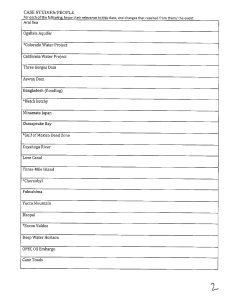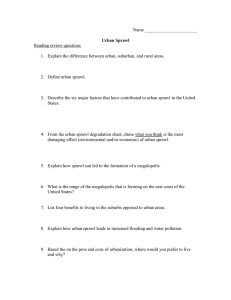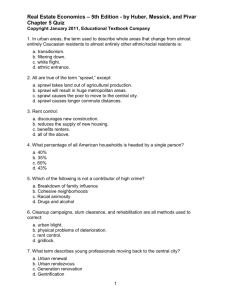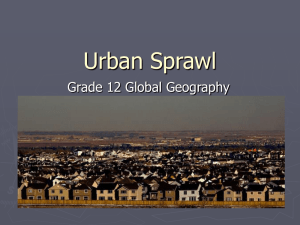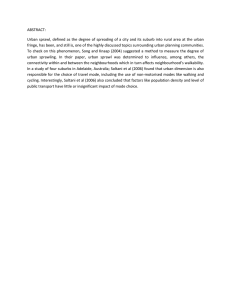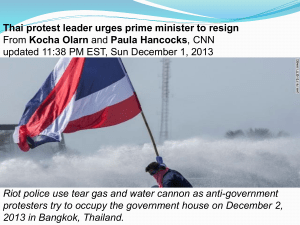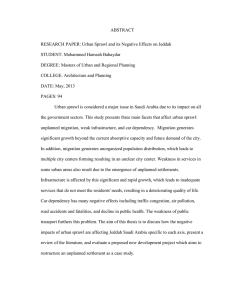Urban Sprawl in North America: Causes, Impacts, and Solutions
advertisement
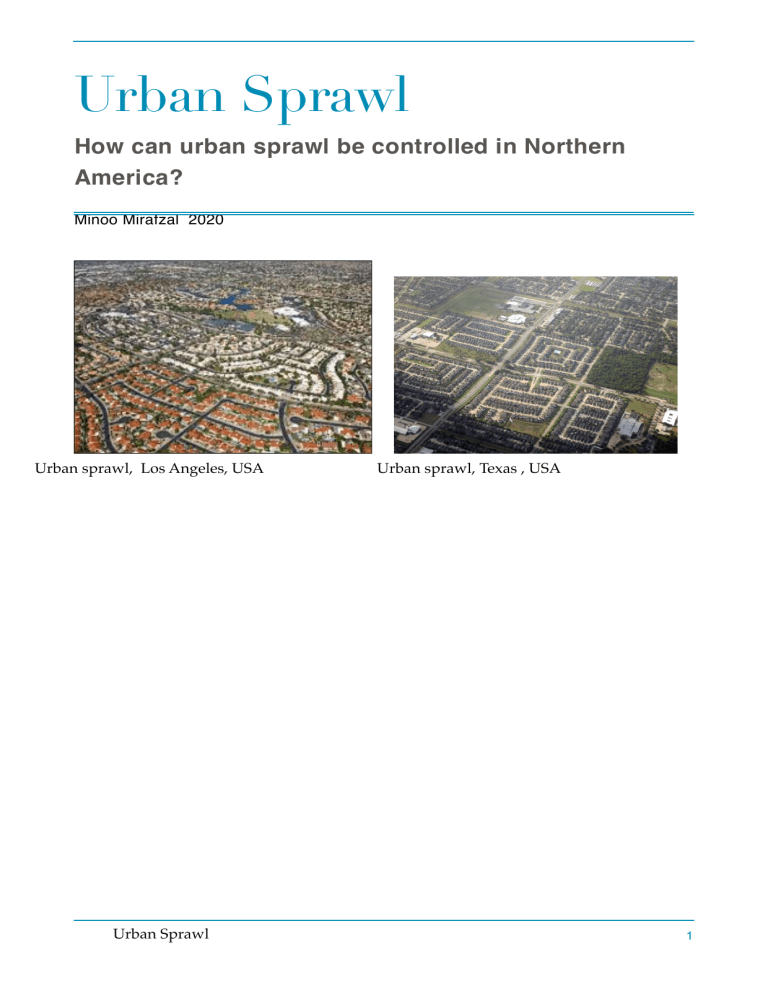
Urban Sprawl How can urban sprawl be controlled in Northern America? Minoo Mirafzal 2020 Urban sprawl, Los Angeles, USA Urban Sprawl Urban sprawl, Texas , USA 1 word boxe: Urban Sprawl infrastructure smart growth sustainable community Introduction Many metropolitan areas in United States and Canada have sprawled, or spread out, farther and farther. Those Americans and Canadians who can afford it often choose to work in a city but live in its suburbs. They are usually attracted by new, up scale housing, better public services, and open space. As suburbs become more numerous, metropolitan areas become larger and more difficult to manage. I/ Growth without plan Poorly planned development that spreads a city’s population over a wider and wider geographical area is called urban sprawl. As outlying areas become more populated, the land between them and the city fills in as well. In the USA and Canada, urban sprawl is becoming a matter of increasing concern. From 1970 to 2000, people who worked in US cities moved farther and farther from urban centres. The population density of cities in the US decreased by more than 20% as people in cities moved to suburbs and outlying areas. About 30,000 square miles of rural lands were gobbled up by housing developments. For example , the population of the city of Chicago decreased during this period from 3.4 million people to 2.8 million. But the Chicago metropolitan area grew from about 7 million persons to 7.3 million. Canada is less populated than the US but faces similar problems. Causes of Urban Sprawl: Sprawl occurs in metropolitan areas that allow unrestricted growth or that have no plan to contain it. Other factors include the widespread use of automobiles and building of expressways. Autos and cheap gasoline enable American to drive many miles to and from their jobs. Despite clogged highway and long commutes, American prefer their cars to mass transit. Expressways provide the means for continued reliance on automobile. Urban Sprawl 2 There are many reasons why Americans have moved to suburbs. Some people want better school and housing. Still others want to try to recapture the sense of community they experienced while growing up. They want their children to know their neighbours and have a backyard in which to play? Only recently urban planner have started to design big-city neighbourhoods to give a sense of community, hoping to slow down the movement to the suburbs. II/ Urban sprawl negative impact Urban sprawl has a negative impact on the quality of life in many ways. As suburbs grow, more commuter traffic stains the infrastructure. Infrastructure, consists of the basic facilities, services, and machinery needed for community to function. For example, roads and bridges needed maintenance. More cars on the road for more time adds to air pollution, too. Also , sources of water, such as rivers or underground aquifers become depleted . Urban sprawl also has other costs. The cost of providing streets, utilities, and other public facilities to suburban communities is often at 25% higher than for high- density residences in a city. Urban sprawl also separates classes of people. When those in upper-income choose to live in outlying areas, lower-income residents often become isolated in innercity areas. III/ Solutions to sprawl More and more cities are developing plans for smart growth, , Which is the efficient use and conservation of land and other resources. Most often it involves encouraging development close to or inside the limits of existing cities. Good public transportation systems help to make smart growth possible by cutting down on auto traffic. Portland’s growth boundary: Oregon's Urban Growth Boundary: https://www.youtube.com/watch?v=1bVtcu79Wzw In 1979, The city of Portland, Oregon, drew a line around itself to create an urban growth boundary. Building was allowed inside the boundary. The surrounding green space was off limits to developers. This decision caused controversy but paid off. Portland has contained urban sprawl. Vancouver’s plan for sustainable communities Urban Sprawl 3 Since 1961, Vancouver, British Columbia, has seen the population of its metropolitan area double. The growth of outlying suburbs often took place at the expense of forest, farm, and flood plains. In 1995, the Greater Vancouver Regional Board Adapted a plan to manage growth. It involved turning suburbs into sustainable communities, that is, communities where residents could live and work. The same solution was applied to Vancouver’s downtown area, where about 40% of its residents now walk to work. This has cut done on commuting. Urban Sprawl 4
